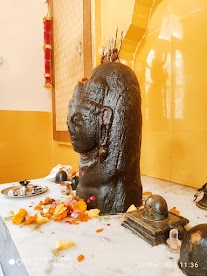Unearthing the Forgotten: The Ancient Bajar Gosain Mandir of Dedpeth Kishtwar
 |
| Ek Mukhi Shivalinga at Bajar Gosai Temple, Daedpeth |
Nestled in the serene village of Dedpeth, on the banks of the Maru River, lies the ancient Bajar Gosain Mandir. This revered temple, serving as the Kuldevta (family deity) for local inhabitants, holds an unknown age.
 |
| Side View of Ek Mukhi Shivlinga |
The Profound History of the Ek Mukhi Shivalinga
At the heart of the Bajar Gosain Mandir is an Ek Mukhi Shivalinga, a unique representation of Lord Shiva with a single face. This iconic form signifies a crucial evolution in Hindu art and philosophy, seamlessly blending Shiva's formless (Nirguna) and manifest (Saguna) aspects. Its rich history is etched in the Vedas and elaborately detailed in the Shiva Purana, where it is revered as an incarnation of Shiva, embodying his immense power and glory. The Ek Mukhi Shivalinga holds profound cultural significance, a testament to Hinduism's rich traditions, and has been worshipped in renowned temples across India, including Kashi Vishvanath, Somnath, Mahakaleshwar, Omkareshwar, and Kedarnath.
.jpeg) |
| Idols outside Temple damaged suring Mughal Invasion |
A Royal Connection and Mughal Invasion
Intriguingly, this very Ek Mukhi Shivalinga was also worshipped as a Kuldevta during the Hindu Shahi dynasty of Kabul. This powerful Hindu dynasty, which reigned from the 7th to 11th centuries, played a pivotal role in preserving Hindu culture across a vast territory encompassing present-day Afghanistan, Pakistan, and northwestern India. Another Ek Mukhi Shivalinga, believed to be from the prehistoric shrine of Adi Varaha, is also found in the Koti Teerath Mandir in Baramulla, Kashmir.
According to Sh. Badrinath Sharma ji, the Bajar Gosain Mandir faced an attempted demolition during the Mughal invasions. Though several idols were vandalized, their remnants remain visible within the temple complex. A captivating local legend recounts that when the Mughals desecrated these idols, Kuldevta Bajar Gosain, in a fit of divine fury, unleashed an army of wasps upon them. Overwhelmed, the Mughal forces retreated in disarray, leading to the divine protection of the Mandir.
Architectural and Artistic Marvels
The Ek Mukhi Shivalinga in Dedpeth, crafted from black stone, is a masterpiece of sculpture. It stands ten inches in diameter and two feet seven inches tall, with a twelve-inch-long and five-inch-carved face. This dual representation, merging the abstract Linga with a human face, powerfully symbolizes the boundless creative and generative energy of nature.
The Mandir complex, spanning approximately one and a half kanal, is currently undergoing construction, with local devotees contributing both physically and financially. According to regional legend, Bajar Gosain has six more divine brothers, making them seven in total, each radiating their presence from different locations: Rong Devta in Sigdi, Mehar Gosain in Mughal Maidan, Varun Devta in Thakarie, Aapat Gosain in Tagood, and two others in Palmar and Sangambatti.
Preserved Relics and Hidden Treasures
Within the Mandir complex, the idols damaged during the Mughal invasion are carefully preserved. These ancient sculptures showcase exquisite craftsmanship, carved from three distinct types of stone. One depicts a four-armed Goddess holding a trident, bow, and kamandal, with one hand resting on a lion's head. Adorned with a garland and an ornate crown, she exudes majesty.
Another severely damaged sculpture, likely of a Goddess, still reveals four hands—one grasping a Shankha, another in a blessing gesture, a third holding a Kamandal, and the fourth resting on another carved figure. At her feet, two female attendants, wearing rosaries, stand poised, one holding a fly whisk. The third statue, likely a deity, features an ornate crown, kundals in its ears, and a beautifully carved face, adorned with necklaces and pearl garlands. Though its right hand is damaged, the left grasps an object, and an attendant is depicted by its side. Adjacent to these sculptures is another Shivalinga, twenty-one inches tall and one foot in diameter, and on the right of the main Mandir, an elevated platform (Chobara) houses several more ancient Shivalingas.
Witnessing these damaged yet masterfully crafted sculptures evokes a sense of regret for their destruction. Every intricate detail, from facial features and hair to ornate crowns, pearl necklaces, garments, and the objects they hold, showcases a skill capable of mesmerizing all who behold them.
 |
| Author Anil Kumar Bhagat at the daedpeth Temple Site |
The Unseen Heritage of Kishtwar
Kishtwar district is a treasure trove of hundreds of ancient Mandirs and shrines, many of which remain undiscovered by the wider public. Dedicated to local deities or Kuldevtas, their existence often goes unnoticed. The frequent unearthing of Shivalingas and deity idols during digging and excavation suggests intentional burial in the past, perhaps to safeguard them from destruction or due to natural disasters. With dedicated effort to document these forgotten Mandirs and share their stories, many more ancient idols and their sacred abodes await rediscovery.
.jpeg) |
| Author at the Daedpeth Temple Site |
Authored by: Anil Kumar Bhagat
Mobile: 7051350159
Email: anilk11111982@gmail.com
Disclaimer:This article presents the author's personal research and interpretation of historical events. www.mykishtwar.com provides this platform for the dissemination of information and diverse perspectives. The accuracy, completeness, and validity of any statements made within this article are solely the responsibility of the author. The content of this article is the sole responsibility of the author. www.mykishtwar.com does not assume any liability for the information presented. The author's views and opinions do not necessarily represent those of www.mykishtwar.com. Readers are encouraged to conduct their own research and verify the information presented.


Very nice peice of article
ReplyDelete